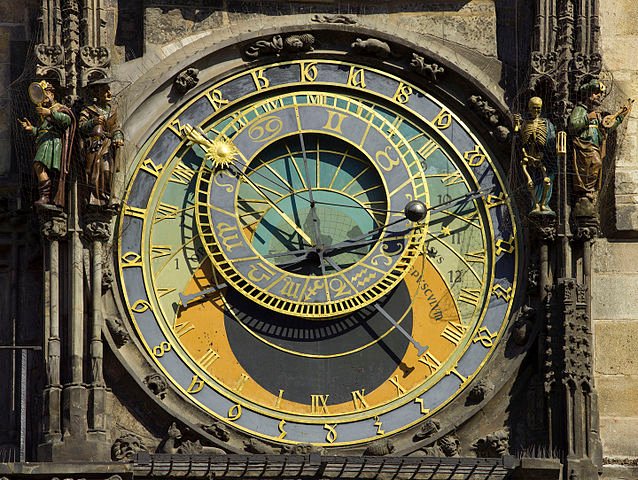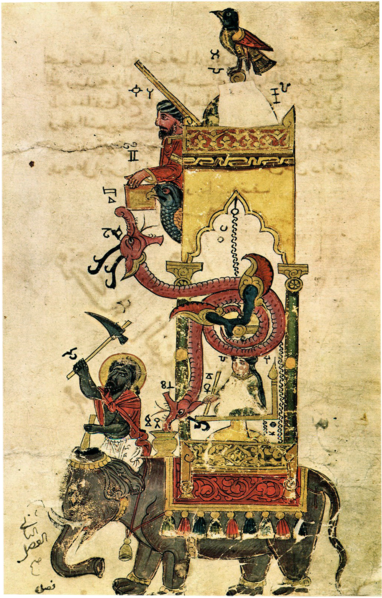While we are not much fascinated by clocks nowadays, as is the case with any technology that becomes too widespread - Yea I know you can easily look at your watch, your phone, or just the screen now and know what time it is :), yet it was not until several hundred years back that telling time became as easily accessible.
It is recorded that the first wrist watches were first accessible in the early 16th century.
So imagine how difficult that was almost a thousand years back? which is the essence of our topic today.
Oh and before this falls off my mind, I am attempting this to be a new series, entitled Amazing Inventions of the Past, to highlight some of those great and often unknown inventions of the past which have shaped our present into how it is.
So, back on track..
Our first invention into the series is, your guessed from the title, called the Elephant Clock, and it was an invention by Al-Jazari.
As usual, definitions are due :)
Who is Al-Jazari?
Badi Az-Zaman Al-Jazari is a Muslim ingenious inventor and polymath who lived in the era 1136 – 1206, worked as chief engineer at the Artuklu Palace - Turkey, and mostly known for his remarkable work on automated machines, robots, and particularly clocks.
His book, The Book of Knowledge of Ingenious Mechanical Devices comprises over 100 mechanical inventions with high level details and sketches for each of his work, which in addition to several various clock designs, included humanoid automata system mostly driven by hydropower, such as his hand washing automaton and flush mechanism (now used in modern flush toilets), musical robot band, and peacock fountain with automated servants to name a few.
Cool Fact: The word Badi' in arabic comes from origin "innovative", and Zaman essentially translates to "Time", and the term Badi' Az-Zaman would mean innovative of his time or across times.
From wikipedia:
Badīʿ az-Zaman Abū l-ʿIzz ibn Ismāʿīl ibn ar-Razāz al-Jazarī (1136–1206, Arabic: بديع الزمان أَبُو اَلْعِزِ بْنُ إسْماعِيلِ بْنُ الرِّزاز الجزري, IPA: [ældʒæzæriː]) was a Muslim polymath: a scholar, inventor, mechanical engineer, artisan, artist and mathematician. He is best known for writing The Book of Knowledge of Ingenious Mechanical Devices in 1206, where he described 100 mechanical devices, some 80 of which are trick vessels of various kinds, along with instructions on how to construct them
Work on clocks
Al-Jazari's work on clocks included both candle-based clocks as well as water clocks, the most prevalent approaches for time monitoring.
Candle based clocks were essentially ones whose mechanism was based on the rate of burning down of the candle to indicate the passage of time along matching charts.

Water clocks on the other hand relied on measuring time through regulated water flow.

He also went beyond time telling and included work on astronomical clocks, which essentially focus on depicting movements of the sun, moon, and stars.
Czech-Prague

The Elephant Clock
The Elephant clock is remarkably one of his most innovative clock designs (in addition to the Castle clock - an astronomical clock which included display of zodiac, lunar, and solar orbits).
It is also considered one of the early signs of multiculturalism in technology. How so?
Well, Al-Jazari reports in his book, upon the completion of the clock, and to acknowledge the diverse sources the knowledge of which he aspired to build this clock, and basically improved upon, the following statement as noted in wikipedia throughout his own words:
"The elephant represents the Indian and African cultures, the two dragons represents ancient Chinese culture, the phoenix represents Persian culture, the water work represents ancient Greek culture, and the turban represents Islamic culture" - Al-Jazari

The innovation in the clock is due to several aspects:
- This was the first clock which included an automaton (we already established Al-Jazari's work on automata above), which basically consisted of a 30 mins automated intervals with a humanoid striking the cymbal, along with a mechanical bird chirping sound (similarly to later clocks' rooster sound)
- It was also the first clock to account for, automatically and without human intervention, the unequal length of the day throughout the year and maintaining accuracy.
Mechanics: (TL;DR but fun :) - yet you can also skip to the video below for a great 3D animation detailing the workings)
The mechanics of the clock operate via water tanks hidden inside the elephant's belly.
Being a water based clock, a bucket with a small hole in the middle, floating in the water, gets filled every half an hour.
A string that is attached to the top of the clock on the one hand, and to the now sinking bucket on the other, gets pulled by the sinking action and hence initiates the release of a ball, that drops from the falcon's beak inside one of the two serpent's mouth causing it to slide down via the ball's weight.
The movement of the serpent, also attached to the bawl, cause the bowl to move out of the water again, empty now, and re-initiate the sequence with the snake moving back to the top due to the drop of the ball from the mouth of the snake into a lower bowl.
In parallel, strings attached to a humanoid - the elephant driver, also cause it to initiate the hitting the drum, announcing a sound at every half hour interval due to the ball dropping effect.
The mechanism also included not one but two bowls of water, the purpose of which was to account for the second point in innovation section above, being the temporal hours adjustments and maintaining accurate hour and day lengths. The lower water tank was connected to the top tank, and a flow regulating mechanism in effect occurred at day break, causing water to flow from the top to the lower tank to maintain a constant pressure via a connected float regulator.
Animation Video Depicted the internal workings of the Elephant Clock - you can start at min 2:41

Current day Elephant Clock
The Elephant Clock has been reproduced according to Al-Jazari's exact designs.
A real life reconstructed and working model can be found in Dubai, at "Ibn Battuta Mall". The image of which is at the top of the post.
So if you are planning a visit soon to Dubai, you might as well want to put this on your list :)
Few other reproductions are also available, one at the "Musée d'Horlogerie du Locle", Le Locle - Switzerland, a second at "Museum of Science and Technology in Islam", KSA, and a third at Kasımiye Medrese, in Mardin - Turkey.
The 1001 Inventions organisation, which tours the world as an educational science show, had also produced a five meter high, working replica of the Elephant Clock available at the London Science Museum.
Hope you found this interesting, and thank you for reading through :)
References:
- https://en.wikipedia.org/wiki/History_of_timekeeping_devices
- https://en.wikipedia.org/wiki/Ismail_al-Jazari
- https://en.wikipedia.org/wiki/Elephant_clock
- http://www.muslimheritage.com/article/al-jazari-mechanical-genius
- https://en.wikipedia.org/wiki/Candle_clock
- https://en.wikipedia.org/wiki/Water_clock
- https://www.atlasobscura.com/places/elephant-clock
Photo Credits:
A Proud member of steemSTEM
SteemSTEM is a project that aims to increase both the quality as well as visibility of Science, Technology, Engineering and Mathematics (and Health). You can check out some great scientific articles via visiting the project tag #steemSTEM , project page @steemstem, or connecting with us on chat https://steemit.chat/channel/steemSTEM
A Proud member of MAP (Minnows Accelerator Project)
MAP is a growing community helping talented minnows accelerate their growth on Steemit.
To join, check out the link at the home page of @accelerator account
Prior Posts:
- Idée Fausse #8: La césarienne prends son nom après Jules César
- What Do You Know About Time Crystals - The Newest State Of Matter?
- Idée Fausse #7: Néron avait enflammé Rome et la regardait brûler
- Idée Fausse #6: Les Chocs à Basse Tension ne Sont pas Dangereux
- Coding For Dummies: Make Your First API Call to Steem in 5 Quick Steps
- Idée Fausse #5: Le Mont Everest est le plus haut de la planète
- 15 Amazing Things You Can Do Via Google - Besides Common Search
- [FR] Idée Fausse #4: Le Son Des Canards N'a Pas D'écho
- Science Judges: To Pee Standing Or To Pee Sitting - That Is A Men's Question
- [FR] Idée Fausse #3: Les Autruches Enterrent Leur Têtes Dans Le Sable Lorsqu'ils Ont Peur
- Scientific Breakthrough: Missing Half Of Our Universe's Matter Finally Found!
- [FR] Idée Fausse #2: L'eau est un bon conducteur d'électricité
- What Do We Really Know About Cholesterol? And New Study Findings: Very High HDL Levels Linked To Higher Mortality
- [FR] Idée Fausse #1: Les Humains Ont Seulement 5 Sens
- Scientific Finding: 100 Million Year Old Virus Found In Blood Of Pregnant Women
- Weird Science: Tears Can Now Generate Electricity !
- French Post: Mon Premier Article Français - Bonsoir Les Francophones :)
- Nobel Prize: Discovery of "How" Humans Adapt Their Biological Rhythms to the Rotation of Planet Earth!
